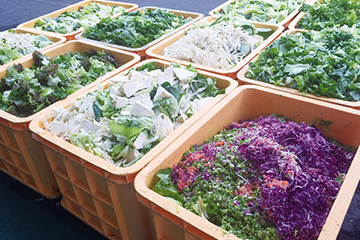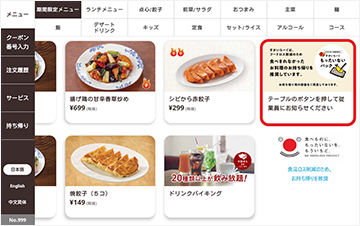Our Approach
Skylark Group recognizes its responsibility to produce and use food responsibly, and works to reduce food loss.
- We will reduce food loss in central kitchens and at stores.
- We will prepare an environment where customers can choose to minimize leftovers.
- We will recycle food appropriately and proactively.
We believe that the continued generation of food loss by our Group—due to errors in ordering and inventory control, the absence of menu options that allow customers to choose portion sizes, and an increase in leftover food from not preparing to-go containers—has a significant negative impact not only on the global environment, but also on society and our customers.
In response, we have designated “Reduction of Food Loss” as one of our material issues (materiality), formulated the above policy, set KPIs, and are promoting improvements through the implementation of targeted initiatives.
Targets
| Short-term Target |
Improve intensity (per unit sales) by at least 1% per year on average |
| Medium-term Target |
50% reduction from 2018 levels by 2030 |
| Long-term Target |
75% reduction from 2018 levels by 2050 |
The Food Recycling Law requires the "cafeteria/restaurant" industry to reduce food waste to 170 kg/million yen (per net sales) or less. Our group has set a high target of further improvement of 1% or more every year against 74.51kg/million yen in 2018.
Target by Item
Risks/Opportunities
Indicators/KPI
Measuring the Amount of Food Loss
To identify areas for improvement, we calculate food loss by disaggregating it by store, factory, and ingredient, based on daily ordering and inventory data. We also calculate waste volume and cost for each store, based on waste measurement data.
Using these data, we implement product management plans and operational guidance tailored to the characteristics of each store (such as location and sales volume) to reduce food loss.
Example of Activities
Initiatives in Our Central Kitchens

When processing food ingredients in our central kitchens, we set KPIs on yield loss for each vegetable in order to reduce food loss. For example, we try to reduce the amount of waste by reviewing the cutting method for onions used for dumplings and thereby reducing portions that had been thrown away and utilizing portions of green onions close to the root for soup stock and not letting much go to waste. Another approach to reducing waste is employee education. We provide our employees with manuals which give detailed guidance on procedures such as the order for measuring ingredients and order for injecting ingredients for increased accuracy of ingredient management in order to reduce processing and measurement errors while maintaining quality.
In addition, we effectively control inventory expiration dates and ensure to use ingredients before they expire. Any off-specification products that are manufactured are sold to employees or served in our employee cafeteria in an effort to reduce food loss.
In our central kitchens, we measure our initiatives quantitatively and continue to make improvements. Furthermore, by increasing the ratio of highly processed products which are processed internally in our centerral kitchens, we are reducing cooking operations in stores as well as reducing food loss at the store level.
Despite the above initiatives, some food waste is still generated. Food waste that is generated is recycled into fertilizers or animal feed, and the food recycling rate in our central kitchens is 90%.
Initiatives at the Store Level


We manage our store inventory with an automated ordering system which appropriately controls the order quantity of various food ingredients. And this is made possible through our daily delivery system to our stores.
Our store inventory is strictly managed by storing food ingredients in an appropriate way and keeping track of expiration dates. To optimize shelf-life, we review our manufacturing processes and storage temperatures, and extend food expiration dates based on scientific evidence. On the other hand, if a cooking mistake occurs, we ensure to serve customers with products of consistent quality by cooking the product again from the start without hesitation. To minimize such mistakes in cooking and measuring, we educate and train our employees through cooking manuals which are easy to understand using videos and images, and held an online “Food Loss Reduction Study Session” for store employees in May 2023 to supplement knowledge and share countermeasure examples for reduction. In addition, since each store generates different amounts and types of waste, reduction measures and KPIs are determined for each individual store during monthly meetings with superiors and are linked to actions.
In this way, we are strengthening employee education and training for waste reduction.
We have also devised ways to ensure that customers can enjoy just the right amount of rice, such as making it possible to select the amount of rice they want to eat. We have also made it possible for customers to order only the main item of set meals.
For those who still have leftovers, "Mottainai Packs" are available for take-out upon request (some all-you-can-eat brands and take-out of uncooked foods are not eligible). Customers can request the Mottainai Pack by clicking on the dedicated button in the digital menu book.
Food Waste Reduction Subcommittee
A food waste reduction subcommittee was established in 2022 as a subordinate organization of the Group Sustainability Committee to work on food waste reduction across the entire company.
The subcommittee has been working to reduce waste through the following initiatives.
Accurate Calculations
The amount and type of waste generated at the stores used to be weighed only by the company itself, but we have asked our suppliers to weigh our waste as well to obtain more accurate data, which will lead to reduction measures.
Establishment of annual reduction KPIs
Based on accurate waste volume calculations, we set KPIs for annual reductions and report quarterly on waste volume and reduction efforts to the Sustainability Committee.
Initiatives to Reduce
As an example of our initiatives, we launched the “Komamedori Project” to reduce food waste at all Shabu-shabu all-you-can-eat “Syabu-yo” restaurants. The project proposed an “environmentally friendly way of eating” that addresses the social issue of food loss.
Recycle
At the factories, vegetable and meat scraps are recycled into fertilizer or feed, and the recycling rate is approximately 90%. At our stores, waste cooking oil is 100% recycled into feed, oil and fat products. Our subcommittee is conducting research on the recycling of waste materials other than waste cooking oil.
Waste Reduction
In addition to the food waste mentioned above, our group is also promoting the reduction of plastic waste. For disposable plastics, the Group Sustainability Committee and its two subcommittees—the "Packaging Materials Review Subcommittee" and the "Consumables Reduction Subcommittee"—are leading the efforts for reduction.
These two subcommittees were established in 2021. To date, they have worked to reduce disposable container packaging for delivery and takeout, as well as plastic bags and trash bags, by modifying and optimizing their sizes and thicknesses. Furthermore, reductions have been achieved by charging for disposable cutlery and plastic bags.
For the charged cutlery, 10% of the sales are donated to the Green Fund (National Land Afforestation Promotion Organization, a public interest incorporated association) for the purpose of forest maintenance and greening promotion.
(2023 Sales: JPY 20,225,310; Donation: JPY 2,022,531; 2024 Sales: JPY 25,530,930; Donation: JPY 2,553,093)
We will continue to promote efforts to achieve our target of a 50% reduction from the 2020 level by 2026.